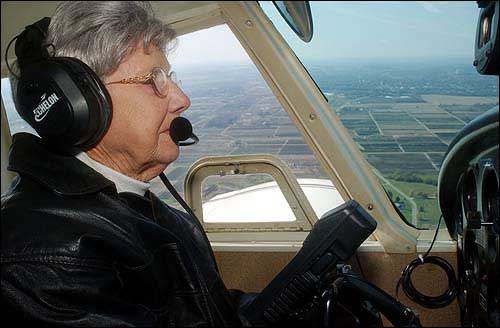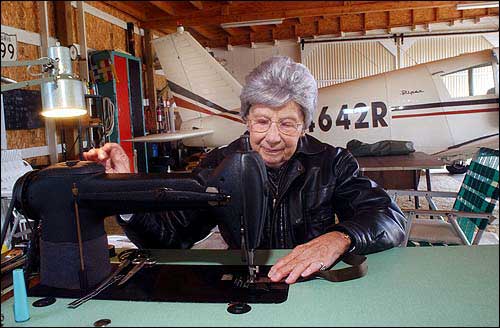Flying octogenarian pilots own course
New Carlisle, Ohio ? As the November winds bump and jostle the small plane, the pilot wrestles the aircraft into landing position and tiptoes it down on a short strip of grass runway.
The single-engine Cherokee 140 begins to veer left and is deftly righted, pulling up short of the bales of hay that frame a nursery at the end of the landing strip at Andy Barnhart Memorial Airport.
The four-seater is pushed into a hangar, and out climbs Violet “Vi” Blowers, silver-haired, 4-foot-10, wearing a tan pantsuit, amber-tinted clip-on sunglasses and white tennis shoes. She is back from lunch in Bluffton, a 66-mile hop she makes nearly every Monday.
At 84, she is the most active pilot at Andy Barnhart, logging 4,000 hours on the Cherokee she has owned since 1972. Her monthly fuel bill alone averages $300.
To say Blowers loves to fly only hints at a passion she has had for 36 years.
She is one of only 12 women in the United Flying Octogenarians, a 420-member club for U.S. pilots age 80 and older.
Blowers cares for her ivory-colored Cherokee like a teenage boy with his first car. She sets it on the grass runway instead of the concrete strip to save wear and tear on the tires. She keeps the aluminum sparkling, drawing good-natured chortles from fellow pilots.
“They tease me,” she said. “Every time I get a bug on there I’m washing it off.”
Blowers caught the flying fever in the 1960s when a friend let her steer his plane during a flight from Florida to Ohio. When her husband, Emmitt, suggested they take up gliding, she insisted on learning to fly planes. She wanted to go places.
The couple took lessons together and got their licenses a week apart in 1967, even before she got her driver’s license.

Violet Blowers, 84, flies her 1966 Cherokee 140 over New Carlisle, Ohio. The number of people age 80 and older who hold active-pilot medical certificates in the United States is 3,111 this year, up from 1,948 just three years ago, according to the Federal Aviation Administration.
Since then, the sky has been Blowers’ little getaway.
“I think this keeps her young,” said Paul Carter, a 62-year-old pilot who also owns a hangar at the airport.
Rising numbers
The Federal Aviation Administration sets no maximum age for pilots, but every two years, those 40 and older must obtain medical certificates from doctors selected by the FAA. They must pass vision and hearing tests, and can be disqualified for certain conditions, including heart problems and epilepsy.
This year, 3,111 people age 80 and older hold active-pilot medical certificates in the United States, an increase from 1,948 just three years ago. Bob Vandel, executive vice president of the nonprofit Flight Safety Foundation based in Alexandria, Va., believes the rising number of older pilots is directly tied to the country’s aging population.
Seasoned flier
A petite woman with a boundless spirit, Blowers has been in 55 air races and has won more than 20 trophies.
“I always look forward to her coming in on Mondays,” said Kenny Wortman, a 70-year-old maintenance man at the Bluffton airport where Blowers had left the Cherokee while she lunched with a friend. “Some of the guys around here need to take lessons off of her to learn how to land a plane. She puts that airplane on like a glove.”
Most of Blowers’ trips — to Mount Victory, Middletown, Urbana — are short hops. They keep her sharp. She flies around the state to monthly meetings of The Ninety-Nines, a national organization founded in 1929 by 99 female pilots who support and advance aviation.
“She’s just an unbelievable person,” said her 63-year-old nephew, Jeffrey Jenkins. “She’s very energetic, adventuresome. She’s done so many things no one in the rest of the family has done.”
Busy seamstress
The former Violet Weller was the youngest of four children who grew up on a family farm near East Fultonham in southeast Ohio. Like so many girls at that time, she learned to sew when she was 10. She graduated from Zanesville High School in 1937 and two years later married Emmitt Blowers.
During World War II, Violet moved to New London, Conn., so she could be near her husband, who served on a Navy submarine. When he was transferred to Pearl Harbor, Violet returned to Ohio and put her sewing skills to work, landing a job as a seamstress at nearby Wright-Patterson Air Force Base.
She made prototype uniforms for the Air Force and flight uniforms for the Thunderbirds, the aerobatic F-16 pilots. She later made flight jackets for former presidents Richard Nixon, Gerald Ford, Jimmy Carter and Ronald Reagan.
“She still hasn’t completely retired. She told me she was making a uniform for a general the other day,” said friend Dottie Anderson, of Bluffton. “And she makes all of her own clothes. They’re just gorgeous.”
But sewing still takes second to the air up there.

Violet Blowers uses a sewing machine set up in her hangar to make cloth parts for an antique airplane. Blowers has sewn flight jackets for U.S. presidents.
“It’s a thrill every time I go up,” Blowers said.
Close calls
Her time in the skies has not come without a few scares.
Two years ago she was flying to Oshkosh, Wis., when the vacuum pump, which disables indicator dials, failed. Without it, pilots can become disoriented.
She pressed on for fear there wouldn’t be a replacement pump at a nearby airport. “I just had to ignore it,” she said evenly.
Once in the late 1970s, her engine shut down as she was flying home from Xenia, 18 miles away. She was able to safely glide the plane in for a landing.
“I was all right until I got there, and then I just shook all over,” Blowers recalled.
For about six weeks her flights will be grounded while her mechanic overhauls the Cherokee’s 150-horsepower Textron Lycoming engine.
Grounded, maybe, but this is a woman who looks to the horizon with a twinkle in her eye. Clearly, she has no plans to fold up her wings.
“When the time comes,” she said, “I think I’ll know.”

